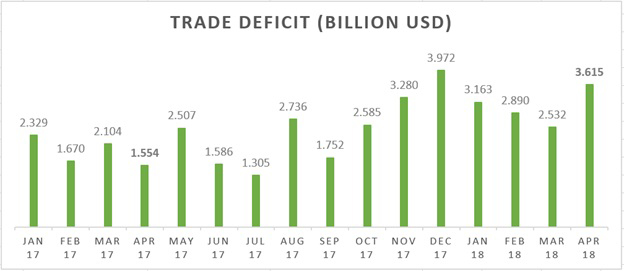PH trade deficit widens sharply in April as imports surge | ABS-CBN
ADVERTISEMENT

Welcome, Kapamilya! We use cookies to improve your browsing experience. Continuing to use this site means you agree to our use of cookies. Tell me more!
PH trade deficit widens sharply in April as imports surge
PH trade deficit widens sharply in April as imports surge
Reuters
Published Jun 08, 2018 11:57 AM PHT
|
Updated Jun 08, 2018 12:02 PM PHT
MANILA - The Philippines' trade deficit widened to a four-month high in April on robust purchases of capital and consumer goods abroad and as weak demand overseas dented exports, the statistics agency said on Friday.
MANILA - The Philippines' trade deficit widened to a four-month high in April on robust purchases of capital and consumer goods abroad and as weak demand overseas dented exports, the statistics agency said on Friday.
The trade gap swelled 43 percent to $3.62 billion in April versus March as demand for telecommunication and transport equipment, and iron and steel, saw imports rising by a near two-year high of 22.2 percent.
The trade gap swelled 43 percent to $3.62 billion in April versus March as demand for telecommunication and transport equipment, and iron and steel, saw imports rising by a near two-year high of 22.2 percent.
Sluggish demand from top trading partners Japan and China caused exports to shrink 8.5 percent, which was the biggest decline since July 2016. Exports to Japan and China dropped 30.2 and 4.6 percent, respectively.
Sluggish demand from top trading partners Japan and China caused exports to shrink 8.5 percent, which was the biggest decline since July 2016. Exports to Japan and China dropped 30.2 and 4.6 percent, respectively.
However, there were some bright spots on the exports side, with shipments to the United States up 14.1 percent in April.
However, there were some bright spots on the exports side, with shipments to the United States up 14.1 percent in April.
ADVERTISEMENT
The rise in imports was partly driven by the government's $180 billion program to overhaul the country's outdated infrastructure to lift economic growth and attract investments.
The rise in imports was partly driven by the government's $180 billion program to overhaul the country's outdated infrastructure to lift economic growth and attract investments.
The import-driven trade gap could worsen the current account deficit, which will put further pressure on the peso, Khoon Goh, head of Asia research at ANZ, said in a tweet.
The import-driven trade gap could worsen the current account deficit, which will put further pressure on the peso, Khoon Goh, head of Asia research at ANZ, said in a tweet.
The peso was hovering near 12-year lows against the dollar after the data was released. It remains Asia's worst performing currency.
The peso was hovering near 12-year lows against the dollar after the data was released. It remains Asia's worst performing currency.
The central bank has forecast a current account deficit of $700 million this year or 0.2 percent of GDP, narrower than last year's deficit of $2.5 billion, which accounted for 0.8 percent of the country's gross domestic product (GDP). The 2016 deficit was 0.4 percent of GDP.
The central bank has forecast a current account deficit of $700 million this year or 0.2 percent of GDP, narrower than last year's deficit of $2.5 billion, which accounted for 0.8 percent of the country's gross domestic product (GDP). The 2016 deficit was 0.4 percent of GDP.
Policymakers have said the current account deficit reflects the Philippines' solid economic expansion, which has driven higher imports of capital goods, raw materials, and other commodity items.
Policymakers have said the current account deficit reflects the Philippines' solid economic expansion, which has driven higher imports of capital goods, raw materials, and other commodity items.
The Philippine economy clocked 6.8 percent annual growth in the first quarter, faster than the fourth quarter's 6.5 percent growth, but short of its 7-8 percent target for the year.
The Philippine economy clocked 6.8 percent annual growth in the first quarter, faster than the fourth quarter's 6.5 percent growth, but short of its 7-8 percent target for the year.
ADVERTISEMENT
ADVERTISEMENT






